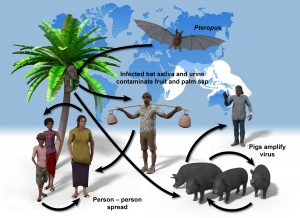Transmission of Nipah virus
Nipah virus is an infection of animals transmissible to people (i.e. a “zoonosis”). Spillover of Nipah and other viruses from their animal reservoirs to humans is an increasingly frequent event, largely as a result of human encroachment on the environment and human behaviors that increase contact with wild animals. The wild animal reservoir of Nipah virus is comprised of fruit-eating bats of the genus Pteropus (flying foxes or fruit bats). In the case of Nipah and a number of other emerging zoonoses, transmission may not stop with the transfer of virus from a bat to a human, but can be perpetuated by human-to-human spread by the respiratory route, creating the potential for an epidemic.
Transmission of virus from bats to humans occurs through direct contact with bat feces, urine or saliva, ingestion of fruits or objects (“fomites”) contaminated with their excretions and secretions. Pteropus spp. are large, fruit-eating bats and congregate to feed where fruit trees are grown near human habitations. People in the endemic area cultivate date palm (‘Toddy palm’) trees from which both fruit and sap is harvested and consumed raw or fermented as wine (watch video). Pteropus bats have been photographed licking sap from the collection stream on Toddy trees. Virus-contaminated palm tree sap is the principal vehicle by which human infection occurs. Date palm harvest season is December to May, corresponding to the period when Nipah outbreaks occur. In addition to palm sap, bats are widely hunted for meat consumption, an activity that can cause human infection. Although the common denominator in the transmission of Nipah virus to humans is the Pteropus bat, domestic animals, especially pigs, may sometimes be involved as intermediate hosts, explaining differences in the epidemiology of the disease in different parts of south Asia. In outbreaks in Malaysia and Singapore, pigs raised in large numbers farms were infected, presumably from feeding on bat-bitten fallen fruit, and the virus may be amplified in pigs by direct pig-to-pig contact spread and be a the principle source of human infection. Pig farming is not widely practiced in Bangladesh1Pig production (Bangladesh) Pigs are distributed throughout the country. Higher concentration is noticed in the districts of Rangamati, Comilla, Sylhet, Mymensingh, Gazipur, Tangail, Feni and Noakhali. However, nomadic flocks of pig are seen to move in most of the districts of the country. Pig production systems in Bangladesh are mainly of two types i) semi-intensive- mainly kept by tribal peoples and who rear at their homestead areas and ii) extensive- nomadic peoples who rear pigs in flocks through continuous shifting of their scavenging areas.”http://www.fao.org/tempref/docrep/fao/010/a1250e/annexes/CountryReports/Bangladesh.pdf2Transbound Emerg Dis. 2020 Feb 25. doi: 10.1111/tbed.13527. Online ahead of print. A Further Outbreak of Classical Swine Fever in Indigenous Pigs in Kurugram District, Bangladesh Md Golam Azam Chowdhuary, Sk Shaheenur Islam , Abul Khair, Md Mehedi Hossain, Garba Ahmed, Eric Brum, Nitish Chandra Debnath, Shukes Chandra Badhy, Mohammed Ahasan Habib, Tanzida Begum Rumi, Akm Anisur Rahman, Michael P Ward where these animals play a minor role in human infection. Other animals including dogs, cattle and goats may become infected but there is no evidence for a role in human infection.
 Human-to-human transmission occurs by direct contact (respiratory droplets), and Nipah virus has been detected in saliva.3Homaira N et al. Nipah virus outbreak with person-to-person transmission in a district of Bangladesh, 2007. Epidemiol Infect 2010;138:1630–1636.4Luby SP et al. Transmission of human infection with Nipah virus. Clin Infect Dis 2009;49: 1743–1748 In a study of 248 Nipah cases occurring in Bangladesh over 14 years, 82 (33%) were due to human-human spread.5Nikolay B et al. Transmission of Nipah virus- 14 years of investigations in Bangladesh. N Engl J Med 2019;380:1804-1814 The average number of secondary cases for each case was 0.33. However, the number increased with close contact and duration of exposure. Although the risk of secondary spread to contacts has been low, there is a concern that mutations in the viral genome, or adaptation by human-human or pig-pig passage could lead to more a more transmissible virus, or that more transmissible variants of the exist in the natural bat reservoir.
Human-to-human transmission occurs by direct contact (respiratory droplets), and Nipah virus has been detected in saliva.3Homaira N et al. Nipah virus outbreak with person-to-person transmission in a district of Bangladesh, 2007. Epidemiol Infect 2010;138:1630–1636.4Luby SP et al. Transmission of human infection with Nipah virus. Clin Infect Dis 2009;49: 1743–1748 In a study of 248 Nipah cases occurring in Bangladesh over 14 years, 82 (33%) were due to human-human spread.5Nikolay B et al. Transmission of Nipah virus- 14 years of investigations in Bangladesh. N Engl J Med 2019;380:1804-1814 The average number of secondary cases for each case was 0.33. However, the number increased with close contact and duration of exposure. Although the risk of secondary spread to contacts has been low, there is a concern that mutations in the viral genome, or adaptation by human-human or pig-pig passage could lead to more a more transmissible virus, or that more transmissible variants of the exist in the natural bat reservoir.
Pteropus bats have a range wider than the known distribution of Nipah virus (Malaysia, Singapore, Bangladesh, India, Philippines), including East Africa, and some Pacific Islands. Antibodies have been found in bats in Sub-Saharan Africa. It is possible that Nipah or a closely related virus will emerge in areas not currently affected by the disease.
A closely related virus, Hendra, occurs in Pteropus bats in Australia and has caused fatal disease in horses and people in close contact with them. A Hendra vaccine for horses is marketed in Australia.
